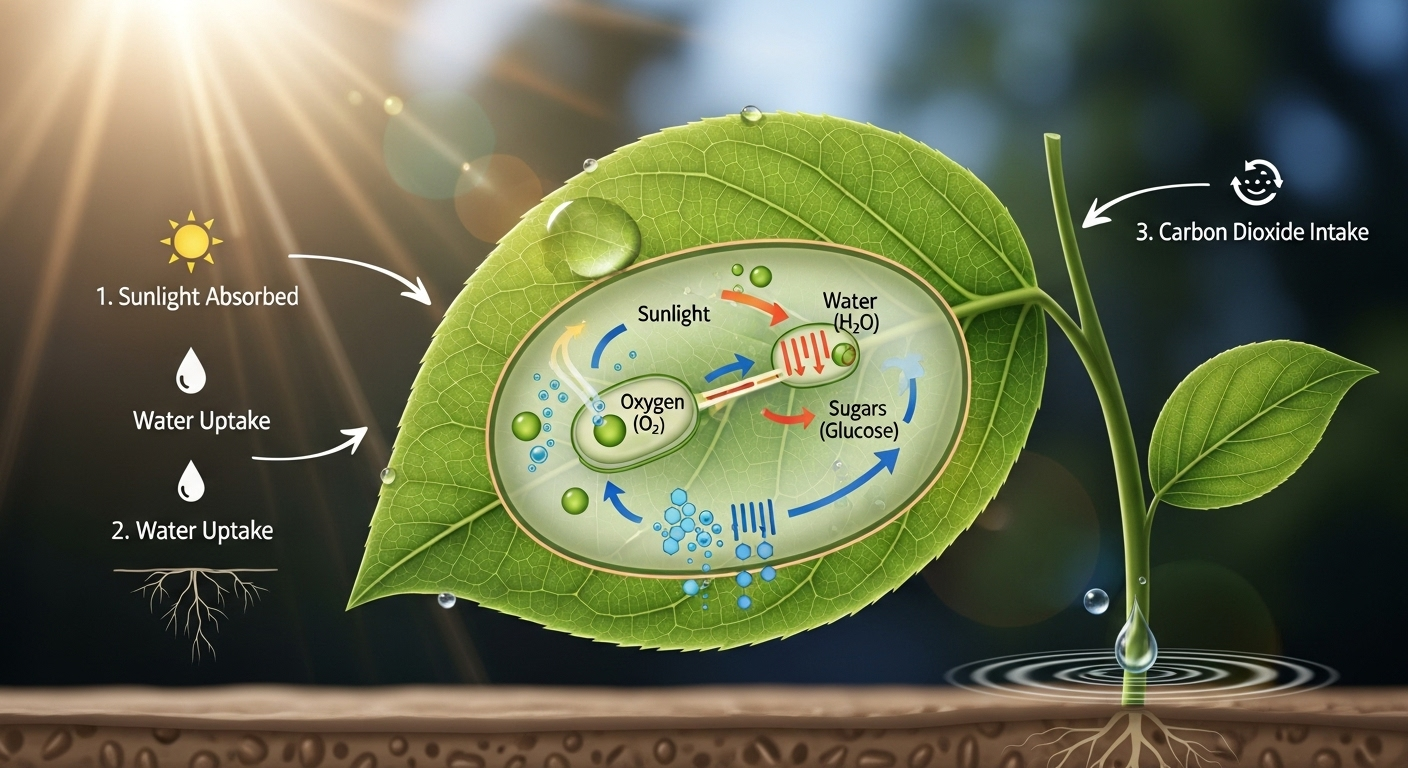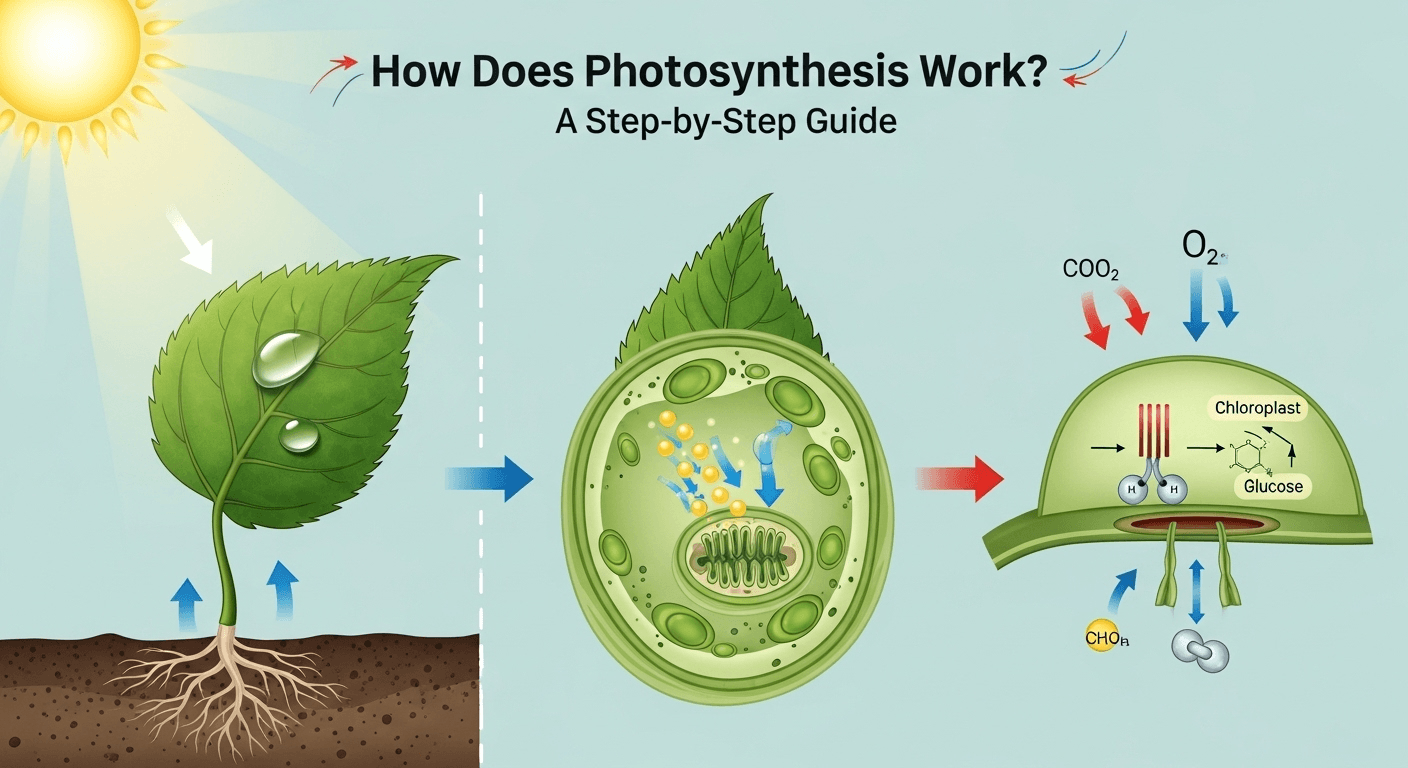Have you ever wondered how a tiny seed can grow into a towering tree, or how the air we breathe gets replenished with life-giving oxygen? The answer to these profound questions lies in a single, elegant biological process: photosynthesis. It is the silent, constant miracle that powers nearly all life on Earth, converting simple sunlight into the chemical energy that fuels ecosystems. Understanding this process is not just for botanists; it's for anyone curious about the fundamental workings of our planet. This guide is designed to explain how does photosynthesis work step by step, breaking down this complex sequence into understandable parts, from the initial capture of a sunbeam to the final creation of a sugar molecule.
Table of Contents
ToggleWhat is Photosynthesis? The Foundation of Life
Photosynthesis is arguably the most important biochemical process on Earth. In its simplest terms, it is the method used by plants, algae, and some bacteria (known as autotrophs) to convert light energy into chemical energy. This chemical energy is then stored in the bonds of carbohydrate molecules, such as glucose (sugar), which the organism can use for fuel. The process uses sunlight, water, and carbon dioxide as its raw materials and releases oxygen as a vital by-product. It is the primary pathway through which energy enters our biosphere, forming the base of almost every food chain.
The grand importance of this process cannot be overstated. Every bite of food you eat, whether it's a vegetable, a fruit, or meat from an animal that ate plants, traces its energy back to photosynthesis. The oxygen in our atmosphere, essential for the respiration of nearly all complex life, including humans, is continuously produced by photosynthetic organisms. This delicate balance, where the waste product of one process (oxygen from photosynthesis) is the essential input for another (respiration), illustrates the deep interconnectedness of life on our planet.
Ultimately, photosynthesis is a story of transformation. It takes inorganic compounds—water (H₂O) from the soil and carbon dioxide (CO₂) from the air—and, using the boundless energy of the sun, forges them into an organic molecule, glucose (C₆H₁₂O₆). This glucose molecule is a versatile packet of energy, ready to be used by the plant for growth, repair, and reproduction. The process is a testament to nature's efficiency, creating the very foundation of biological energy, structure, and the air we breathe from the most basic of ingredients.
The Essential Ingredients: Reactants of Photosynthesis
Before any process can begin, it needs its raw materials. Photosynthesis is no different. It relies on three crucial "ingredients" or reactants from the environment to kickstart the energy conversion process. These components are sourced by the plant through specialized structures, each playing an indispensable role. Without a consistent supply of sunlight, water, and carbon dioxide, the entire photosynthetic engine would grind to a halt, underscoring their collective importance.
Sunlight: The Ultimate Energy Source
Sunlight is the primary driver of photosynthesis. It is a form of electromagnetic radiation, composed of tiny packets of energy called photons. Plants have evolved sophisticated mechanisms to capture these photons, specifically those within the visible light spectrum. While we see sunlight as white, it is actually a rainbow of different colors, each with a different wavelength and energy level. Plant pigments, primarily chlorophyll, are especially good at absorbing light from the blue-violet and red-orange parts of the spectrum, while reflecting green light, which is why plants appear green to our eyes.
This captured light energy is not used directly to build sugar. Instead, its first job is to energize electrons within the plant's pigment molecules. This initial "excitation" of electrons is the critical first step that converts light energy into a temporary form of chemical energy. Think of it like using a solar panel to charge a battery; the sunlight provides the initial power, which is then stored in a more usable format. In photosynthesis, this "battery" comes in the form of molecules like ATP and NADPH, which will be used later to power the construction of sugar.
Carbon Dioxide (CO₂): The Carbon Backbone
If sunlight is the energy, carbon dioxide is the building block. CO₂ is a gas present in the Earth's atmosphere, and it provides the carbon atoms necessary to construct carbohydrate molecules like glucose (C₆H₁₂O₆). Plants "breathe in" carbon dioxide through tiny pores on the surface of their leaves, flowers, or stems called stomata. These stomata can open and close to regulate the exchange of gases and control water loss. When the stomata are open, CO₂ diffuses from the atmosphere into the air spaces within the leaf, eventually reaching the cells where photosynthesis occurs.
The carbon atoms from CO₂ are incorporated into organic molecules in a process known as carbon fixation. This is the cornerstone of the second major stage of photosynthesis, the Calvin Cycle. Essentially, the plant takes the inorganic carbon from the air and "fixes" it into a stable, organic form. This act is the very essence of creating biomass—the physical substance of the plant—out of thin air. It is a remarkable feat of chemistry that forms the basis for all organic matter in the food web.
Water (H₂O): The Electron Donor
Water is the third critical reactant, and it serves multiple functions. Primarily, water is absorbed from the soil through the plant's root system and transported up to the leaves through a network of tissues called the xylem. Inside the photosynthetic cells, during the first stage of photosynthesis, water molecules are split apart in a process called photolysis (which literally means "splitting by light"). This is a crucial event for two reasons.
First, the splitting of water releases electrons. These electrons are used to replace the ones that were energized by sunlight and sent down the electron transport chain. Therefore, water acts as the ultimate electron donor, continuously supplying the electrons needed to keep the energy-capturing process running. Second, a major by-product of splitting water is oxygen (O₂). This is the oxygen that is released into the atmosphere, which we and other aerobic organisms depend on for survival. The protons (H⁺ ions) released from water also play a role in generating a proton gradient that drives the synthesis of ATP.
The Photosynthesis Powerhouse: Inside the Chloroplast
The entire marvel of photosynthesis takes place within a specialized organelle inside the plant cell called the chloroplast. If the cell is a factory, the chloroplast is its solar-powered production line. These tiny, disc-shaped structures are found in abundance in the cells of leaves and green stems, positioned to maximize their exposure to sunlight. The intricate internal structure of the chloroplast is perfectly designed to house the two major stages of photosynthesis: the light-dependent reactions and the light-independent reactions (Calvin Cycle).
Understanding the anatomy of the chloroplast is key to understanding how photosynthesis works. It is not just a simple bag of chemicals; it is a highly organized environment where different reactions happen in specific compartments. This separation is crucial for efficiency, ensuring that the products of one stage can be immediately used in the next without interference. The two most important internal regions are the thylakoids and the stroma.
Thylakoids and Grana: Sites of Light-Dependent Reactions
Embedded within the chloroplast are intricate membrane-bound sacs known as thylakoids. These are the sites of the light-dependent reactions. Think of them as individual solar discs containing all the machinery needed to capture sunlight. These thylakoids are often stacked on top of one another like pancakes, and these stacks are called grana (singular: granum). This stacking arrangement vastly increases the surface area of the thylakoid membranes, allowing for a massive number of light-capturing reactions to occur simultaneously.
The thylakoid membrane itself is where the action happens. It is embedded with chlorophyll and other pigment molecules, as well as the protein complexes that make up the electron transport chain. It is here that sunlight is absorbed, water is split, and the high-energy molecules ATP (adenosine triphosphate) and NADPH (nicotinamide adenine dinucleotide phosphate) are produced. The space inside the thylakoid is called the thylakoid lumen, which plays a role in building up a proton gradient to power ATP synthesis.
Stroma: The Fluid-Filled Space for the Calvin Cycle
Surrounding the grana is a dense, fluid-filled space called the stroma. This is the site of the second stage of photosynthesis: the light-independent reactions, or Calvin Cycle. If the thylakoids are the power generators, the stroma is the assembly plant where the final product is built. The stroma contains the enzymes, ribosomes, and DNA necessary to facilitate the conversion of carbon dioxide into glucose.
The ATP and NADPH molecules produced in the thylakoids are released into the stroma. Here, they provide the chemical energy and reducing power needed to drive the Calvin Cycle. In this cycle, the enzyme RuBisCO captures CO₂ from the air and uses the energy from ATP and NADPH to convert it into a three-carbon sugar (G3P). This sugar can then be used to create glucose and other organic molecules. The stroma provides the perfect aqueous environment for these enzymatic reactions to take place.
Chlorophyll and Other Pigments: Capturing Light
The star player in capturing sunlight is chlorophyll, the pigment that gives plants their characteristic green color. There are two main types in plants, chlorophyll a and chlorophyll b. Chlorophyll a is the principal pigment, directly involved in converting light energy to chemical energy. Chlorophyll b acts as an accessory pigment, absorbing light at different wavelengths and passing the energy onto chlorophyll a.
Plants also contain other accessory pigments, such as carotenoids (which are yellow, orange, or red). These pigments broaden the spectrum of light that can be absorbed for photosynthesis. They also serve a protective role, dissipating excess light energy that could otherwise damage the chlorophyll molecules. This is why leaves change color in the autumn; as the plant reclaims the nitrogen from its chlorophyll molecules, the green color fades, revealing the underlying yellow and orange carotenoids that were there all along.
The First Act: The Light-Dependent Reactions
The first major phase of photosynthesis is aptly named the light-dependent reactions because, as the name implies, it requires a direct input of light. This stage is all about converting light energy into a temporary form of chemical energy. The entire process takes place within the thylakoid membranes of the chloroplasts. The goal is not to create sugar directly, but rather to produce two crucial energy-carrying molecules: ATP and NADPH. These molecules act as rechargeable batteries, providing the power needed for the next stage of photosynthesis.
This first act is a rapid, dynamic sequence of events initiated by the absorption of a photon. It involves the splitting of water, the movement of excited electrons through a series of protein complexes, and the generation of a proton gradient. Think of it as the power-up sequence for the entire photosynthetic factory. It's where raw solar energy is harnessed and transformed into a format that the cell can actually use for metabolic work.
Step 1: Light Absorption and Electron Excitation
The process begins when a photon of light strikes a pigment molecule (like chlorophyll) in a light-harvesting complex called a photosystem. Plants have two types of photosystems, Photosystem II (PSII) and Photosystem I (PSI), which work in sequence. When the photon is absorbed, its energy is transferred to an electron within the chlorophyll molecule, boosting that electron to a higher, more energetic state. This "excited" electron is now unstable and holds the captured light energy.
To prevent this energy from being wasted as heat or light, the high-energy electron is quickly transferred to a specialized molecule called a primary electron acceptor. This marks the crucial conversion of light energy into chemical energy. Meanwhile, to replace the electron it just lost, Photosystem II splits a water molecule (H₂O) in a process called photolysis. This releases two electrons, two protons (H⁺), and one oxygen atom. The oxygen atom combines with another to form O₂, the oxygen gas that is released as a by-product. The electrons from water are used to replenish PSII, allowing the process to repeat.
Step 2: The Electron Transport Chain (ETC)
Once captured by the primary electron acceptor, the excited electron from PSII embarks on a journey down an electron transport chain (ETC). This chain is a series of protein complexes embedded in the thylakoid membrane that pass the electron from one to the next, much like a baton in a relay race. As the electron is passed along, it loses energy at each step.
This is not wasted energy. The energy released by the electron's movement is used by one of the protein complexes (the cytochrome complex) to actively pump protons (H⁺ ions) from the stroma into the thylakoid lumen. This pumping action creates a high concentration of protons inside the lumen, generating a strong electrochemical gradient—a form of potential energy, much like water building up behind a dam. This proton gradient is the key to producing ATP.

Step 3: Creation of ATP and NADPH
After its journey down the first ETC, the now low-energy electron arrives at Photosystem I (PSI). Here, it gets re-energized by another photon of light. This newly re-excited electron is then passed down a second, shorter electron transport chain. At the end of this chain, the electron is transferred to a molecule called NADP⁺ (nicotinamide adenine dinucleotide phosphate), reducing it to NADPH. NADPH is a high-energy electron carrier, a "rechargeable battery" that will carry its energy and electrons to the Calvin Cycle.
Simultaneously, the proton gradient built up in the thylakoid lumen is put to work. The protons flow down their concentration gradient, from the high-concentration lumen back out into the stroma. They can only pass through a special enzyme channel called ATP synthase. As the protons rush through this channel, they cause it to spin, and this rotational energy is used to attach a phosphate group to ADP (adenosine diphosphate), creating ATP. This process is called chemiosmosis, and it is the primary way energy is stored in a usable form for the cell. At the end of the light-dependent reactions, the cell has successfully converted light energy into the chemical energy of ATP and NADPH.
The Second Act: The Light-Independent Reactions (Calvin Cycle)
With the high-energy molecules ATP and NADPH now fully charged, the photosynthetic process moves into its second major phase: the light-independent reactions. This stage is also known as the Calvin Cycle. While these reactions do not directly require light, they are dependent on the products of the light-dependent reactions (ATP and NADPH), so they typically occur during the day when the sun is shining. The primary purpose of the Calvin Cycle is to take carbon from the atmosphere, in the form of CO₂, and use it to build stable, energy-storing sugar molecules.
This cycle is a series of enzymatic reactions that take place in the stroma of the chloroplast. It's often referred to as the "synthesis" part of photosynthesis, as it's where the organic molecule is actually constructed. The cycle can be broken down into three main stages: carbon fixation, reduction, and regeneration. It is a true cycle because the starting molecule of the process is regenerated at the very end, allowing it to continue as long as CO₂, ATP, and NADPH are available.
Step 1: Carbon Fixation
The cycle begins when a molecule of carbon dioxide (CO₂) from the atmosphere enters the stroma. Here, the enzyme RuBisCO (ribulose-1,5-bisphosphate carboxylase/oxygenase), the most abundant protein on Earth, facilitates the first crucial step. RuBisCO attaches the one-carbon CO₂ molecule to a five-carbon sugar that is already present in the stroma, called ribulose-1,5-bisphosphate (RuBP).
The result of this "fixation" is an unstable six-carbon molecule that immediately splits into two molecules of a three-carbon compound called 3-phosphoglycerate (3-PGA). At this point, the inorganic carbon from the air has been successfully incorporated, or "fixed," into an organic molecule within the plant. This is the pivotal moment where carbon from the non-living world enters the living world.
Step 2: Reduction
In the second stage, the newly created 3-PGA molecules are converted into a different three-carbon sugar, glyceraldehyde-3-phosphate (G3P). This step is called reduction because 3-PGA gains electrons, and it requires a significant input of energy. The energy for this conversion is supplied by the ATP and NADPH molecules that were generated during the light-dependent reactions.
Each molecule of 3-PGA receives a phosphate group from ATP and is then reduced by electrons from NADPH. This transforms the 3-PGA into G3P. G3P is the true product of the Calvin Cycle. It is a high-energy, three-carbon sugar that the plant cell can use for various purposes. Some G3P molecules are immediately available to be synthesized into other, more complex carbohydrates like glucose (which requires two G3P molecules), sucrose, or starch for long-term energy storage.
Step 3: Regeneration
While some of the G3P molecules are siphoned off to be used by the plant, most of them remain in the Calvin Cycle. Their job is to regenerate the RuBP molecule that was used up in the first step (carbon fixation). This regeneration step is crucial because it ensures the cycle can continue to fix more CO₂. This stage also requires energy, which is supplied by more ATP from the light-dependent reactions.
For every three molecules of CO₂ that enter the cycle, six molecules of G3P are produced. Of these six G3P molecules, only one is considered a net gain and exits the cycle to be used by the plant. The other five G3P molecules are recycled, undergoing a complex series of reactions to regenerate the three molecules of the five-carbon RuBP starter compound. With RuBP restored, the cycle is ready to accept more CO₂, continuing its tireless work of building sugar from sunlight and air.
The Grand Finale: Products and Importance
After the intricate dance of photons, electrons, and molecules, photosynthesis yields two products that are fundamental to life on Earth: glucose and oxygen. These outputs represent the culmination of the plant's efforts, converting transient light energy into stable chemical energy and releasing a gas that has shaped the evolution of our planet's atmosphere and the life within it. The process is a perfect example of a balanced chemical equation, where raw ingredients are transformed into life-sustaining substances.
The overall balanced chemical equation for photosynthesis is:
6CO₂ (Carbon Dioxide) + 6H₂O (Water) + Light Energy → C₆H₁₂O₆ (Glucose) + 6O₂ (Oxygen)
This simple equation summarizes a deeply complex process. It shows that for every six molecules of carbon dioxide and six molecules of water consumed, the plant produces one molecule of glucose and releases six molecules of oxygen. Below is a table summarizing the two main stages that lead to these final products.
| Feature | Light-Dependent Reactions | Light-Independent Reactions (Calvin Cycle) |
|---|---|---|
| Location | Thylakoid Membranes | Stroma of the Chloroplast |
| Primary Inputs | Sunlight, Water (H₂O), ADP, NADP⁺ | Carbon Dioxide (CO₂), ATP, NADPH |
| Main Outputs | Oxygen (O₂) , ATP, NADPH | Glucose (C₆H₁₁₂O₆) (via G3P), ADP, NADP⁺ |
| Primary Function | Capture light energy and convert it into chemical energy (ATP and NADPH). | Use the chemical energy from ATP and NADPH to synthesize sugar from CO₂. |
| Light Requirement | Direct light required. | No direct light required, but depends on products of the light-dependent reactions. |
The glucose (C₆H₁₂O₆) produced is the plant's primary energy source. It can be immediately used for cellular respiration to power metabolic activities, linked together to form cellulose for building cell walls (structural support), or stored for later use as starch. Oxygen (O₂), initially just a waste product of splitting water, is released into the atmosphere. This release has had profound consequences, enabling the evolution of aerobic respiration, a much more efficient way of extracting energy from food, which allowed for the development of complex, multicellular life, including humans.
Factors Affecting the Rate of Photosynthesis
The efficiency of photosynthesis is not constant; it is influenced by several environmental factors. These are known as limiting factors, because if any one of them is in short supply, it can limit the overall rate of the process, even if the other factors are abundant. Understanding these factors is crucial for agriculture and for predicting how ecosystems might respond to environmental changes. The three main limiting factors are light intensity, carbon dioxide concentration, and temperature.
For instance, at low light levels, the rate of photosynthesis is limited by the amount of light available. As light intensity increases, the rate of photosynthesis increases proportionally, up to a certain point. Beyond this saturation point, increasing the light intensity further has no effect, as the light-capturing machinery of the chloroplasts is working at maximum capacity. At this point, another factor, such as CO₂ concentration, becomes the limiting one.
Similarly, carbon dioxide concentration plays a major role. An increase in CO₂ concentration will increase the rate at which carbon is incorporated into carbohydrates in the Calvin Cycle, and so the rate of photosynthesis generally increases until it is limited by another factor. Finally, temperature affects the enzymes that catalyze the reactions, particularly RuBisCO in the Calvin Cycle. As temperature increases, the rate of photosynthesis increases until it reaches an optimal temperature. Beyond this point, the enzymes begin to denature (lose their shape and function), and the rate of photosynthesis drops off rapidly.
—
Frequently Asked Questions (FAQ)
Q1: Why are most plants green?
A: Plants are green because their cells contain chlorophyll, the primary pigment used for photosynthesis. Chlorophyll is very effective at absorbing light from the blue-violet and red-orange parts of the visible spectrum. However, it does not absorb green light well; instead, it reflects it. Our eyes perceive this reflected light, which is why plants appear green to us.
Q2: Can photosynthesis happen without sunlight?
A: No, not entirely. The process is divided into two stages. The first stage, the light-dependent reactions, absolutely requires light to generate ATP and NADPH. The second stage, the Calvin Cycle, does not directly use light but relies on the products of the first stage. Therefore, while the Calvin Cycle can run for a short time in the dark, the entire process of photosynthesis will quickly stop without a continuous source of light energy.
Q3: What is the difference between photosynthesis and cellular respiration?
A: Photosynthesis and cellular respiration are essentially opposite processes. Photosynthesis captures energy by using sunlight, water, and carbon dioxide to create glucose (energy storage) and oxygen. Cellular respiration releases that stored energy by breaking down glucose with oxygen to produce ATP (usable energy), carbon dioxide, and water. Photosynthesis is performed by autotrophs (like plants), while almost all living organisms, including plants, perform cellular respiration.
Q4: Do all plants photosynthesize?
A: While the vast majority of plants do photosynthesize, there are some exceptions. A small number of plants are parasitic or myco-heterotrophic. These plants have lost the ability to produce their own food and instead derive their nutrients by tapping into other host plants or fungi. A classic example is the ghost plant (Monotropa uniflora), which is entirely white as it lacks chlorophyll.
—
Conclusion
Photosynthesis is far more than a simple chemical reaction; it is the planet's life support system, a solar-powered engine that has been running for billions of years. From the moment a photon of light strikes a leaf to the final construction of a glucose molecule, the process is a step-by-step masterpiece of biological engineering. It takes the most basic ingredients—sunlight, water, and air—and transforms them into the energy and oxygen that sustain nearly all life. Every forest, every blade of grass, and every microscopic alga is a testament to the power and elegance of this process. By understanding how photosynthesis works, we gain a deeper appreciation for the delicate balance of our ecosystem and the quiet, constant work that plants do to make our world habitable.
***
Article Summary
This article provides a comprehensive, step-by-step guide to how photosynthesis works. It begins by defining photosynthesis as the process plants use to convert light energy, water, and carbon dioxide into chemical energy (glucose) and oxygen. The guide details the essential reactants: sunlight as the energy source, carbon dioxide as the carbon source, and water as the electron donor. It then explores the chloroplast, the cellular organelle where photosynthesis occurs, highlighting the roles of the thylakoids and stroma. The core of the article breaks down the two main stages of the process. The first stage, the light-dependent reactions, explains how light energy is captured to produce ATP and NADPH while releasing oxygen. The second stage, the light-independent reactions (Calvin Cycle), details how this chemical energy is used to fix carbon and synthesize G3P, the precursor to glucose. The article concludes by discussing the final products, the factors that limit the rate of photosynthesis, and includes an FAQ section to answer common questions.















